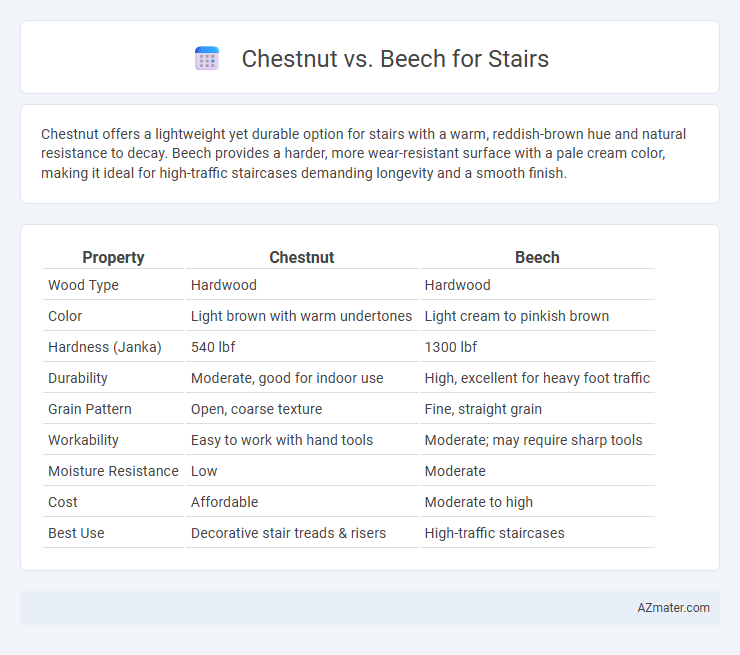Chestnut offers a lightweight yet durable option for stairs with a warm, reddish-brown hue and natural resistance to decay. Beech provides a harder, more wear-resistant surface with a pale cream color, making it ideal for high-traffic staircases demanding longevity and a smooth finish.
Table of Comparison
| Property | Chestnut | Beech |
|---|---|---|
| Wood Type | Hardwood | Hardwood |
| Color | Light brown with warm undertones | Light cream to pinkish brown |
| Hardness (Janka) | 540 lbf | 1300 lbf |
| Durability | Moderate, good for indoor use | High, excellent for heavy foot traffic |
| Grain Pattern | Open, coarse texture | Fine, straight grain |
| Workability | Easy to work with hand tools | Moderate; may require sharp tools |
| Moisture Resistance | Low | Moderate |
| Cost | Affordable | Moderate to high |
| Best Use | Decorative stair treads & risers | High-traffic staircases |
Introduction to Chestnut and Beech Wood
Chestnut wood is prized for its durability and light brown to reddish color, making it a popular choice for staircases that require both strength and aesthetic appeal. Beech wood is known for its fine grain, pale cream color, and high shock resistance, offering a smooth finish and excellent wear properties ideal for stair treads and railings. Both woods provide solid structural integrity and attractive natural patterns, but chestnut tends to be more rot-resistant, while beech offers superior hardness and uniform texture.
Physical Appearance and Grain Differences
Chestnut wood features a warm, golden-brown hue with prominent, coarse grain patterns that give stairs a rustic and natural aesthetic. Beech wood displays a lighter, creamy color with a fine, even grain, resulting in a smooth and uniform appearance ideal for modern stair designs. The contrast between chestnut's textured grain and beech's subtle, straight grain offers distinct visual options for staircases, balancing traditional character and sleek simplicity.
Durability and Hardness Comparison
Chestnut wood offers moderate durability with a Janka hardness rating around 540, making it relatively softer and more susceptible to dents and scratches compared to Beech. Beech hardwood, with a Janka hardness rating near 1300, provides significantly higher resistance to wear, impact, and heavy foot traffic, ideal for staircases requiring long-lasting strength. The enhanced hardness and durability of Beech make it a preferred choice for stair materials demanding robust performance and longevity.
Workability and Ease of Installation
Chestnut wood offers excellent workability with its moderate hardness and fine grain, making it easier to shape and sand for staircases. Beech is denser and harder, providing high durability but requiring sharper tools and more effort during cutting and fitting. For ease of installation, chestnut's lighter weight and smoother finish typically allow for quicker handling, while beech's toughness demands more precise labor but results in a robust, long-lasting staircase.
Maintenance and Longevity
Chestnut stairs require moderate maintenance with occasional sealing to preserve their natural oils and resist wear, offering good durability over time. Beech stairs demand more frequent finishing due to their fine grain prone to scratches but provide excellent longevity with proper care and refinishing. Both woods are strong choices, but chestnut typically withstands moisture and aging better, reducing long-term upkeep efforts.
Cost and Availability
Chestnut wood is generally more affordable and easier to source compared to beech, making it a cost-effective option for stairs. Beech is denser and harder, often resulting in higher prices and less frequent availability, especially in certain regions. Availability of chestnut is more consistent due to its widespread growth, while beech may require specialized suppliers depending on the location.
Environmental Impact and Sustainability
Chestnut wood for stairs offers a lower environmental impact due to its rapid growth rate and sustainable harvesting practices, resulting in reduced carbon emissions and deforestation risks. Beech, while durable, grows slower and often requires more intensive forestry management, which can contribute to greater habitat disruption and carbon footprint. Selecting chestnut over beech supports sustainability goals by promoting faster forest regeneration and minimizing ecological disturbance.
Best Applications for Stair Design
Chestnut offers natural durability and a warm, reddish-brown hue, making it suitable for traditional and rustic stair designs that require resistance to wear. Beech features a fine, tight grain and light color, ideal for modern, minimalist staircases that emphasize sleekness and smooth finishes. Both woods provide excellent stability, but chestnut excels in outdoor or high-traffic stairs while beech is preferred for indoor, aesthetically refined applications.
Home Aesthetics: Matching Decor with Wood Type
Chestnut wood offers warm, rich tones and pronounced grain patterns that complement rustic, traditional, or farmhouse-style staircases, enhancing cozy and inviting home aesthetics. Beech wood features a lighter, more uniform color with smooth grain, making it ideal for modern, minimalist interiors seeking a clean and airy look. Choosing between chestnut and beech for stairs depends on the desired visual impact, with chestnut adding depth and character while beech provides subtle elegance and versatility.
Final Verdict: Choosing Between Chestnut and Beech for Stairs
Chestnut offers warm tones and durable hardwood ideal for traditional staircases, while beech provides a lighter, fine-grained finish suited for modern designs and high-traffic areas. Beech's superior hardness and resistance to wear make it a practical choice for longevity, whereas chestnut's rich color enhances aesthetic appeal. The final decision depends on balancing durability needs with desired staircase style and color preference.

Infographic: Chestnut vs Beech for Stair
 azmater.com
azmater.com